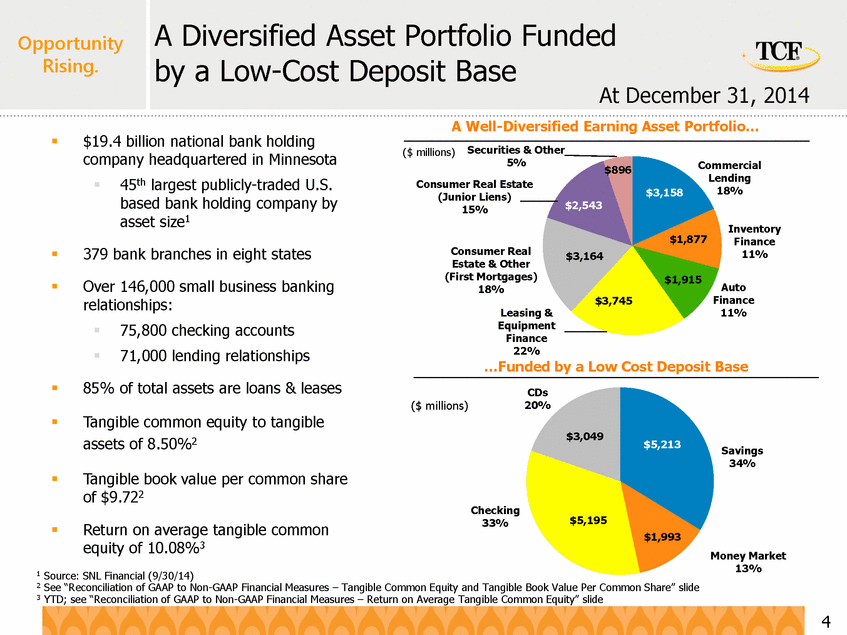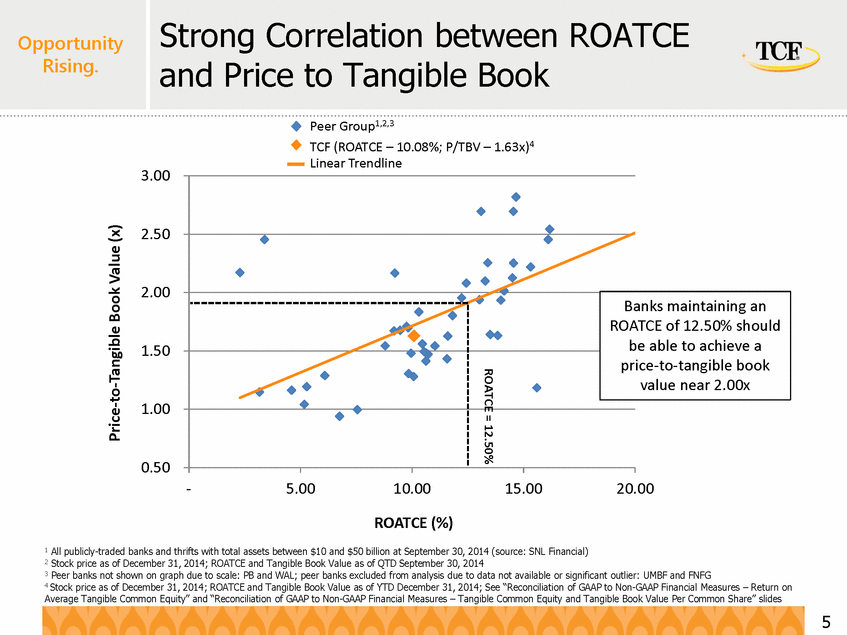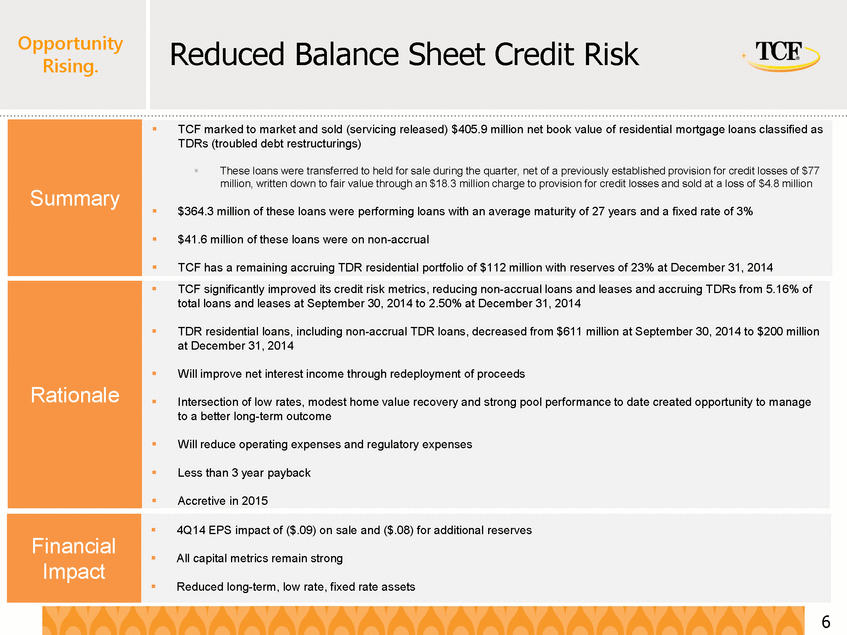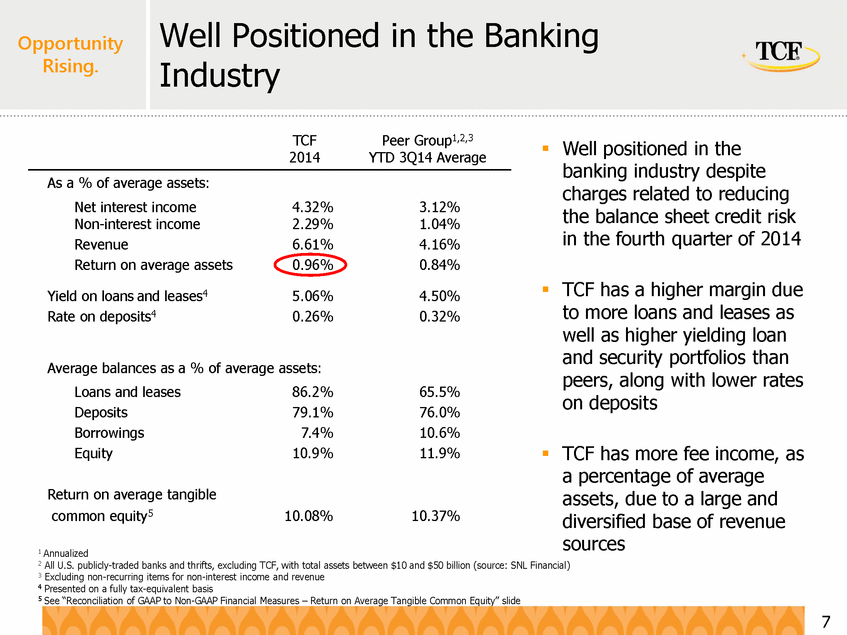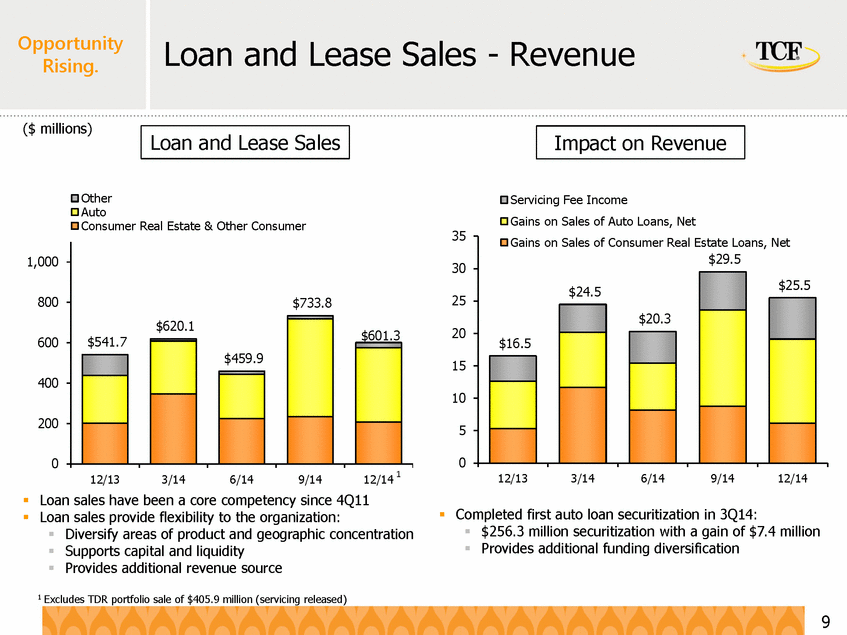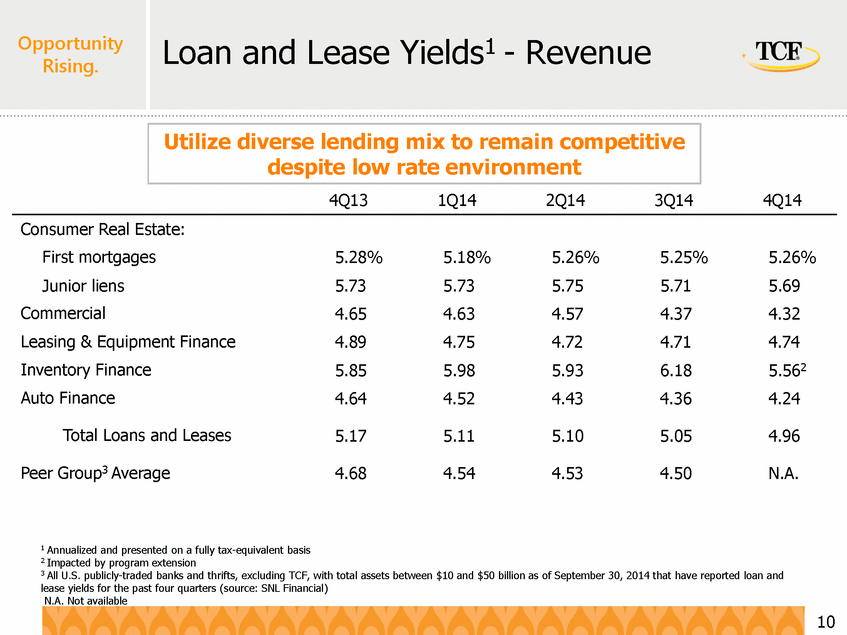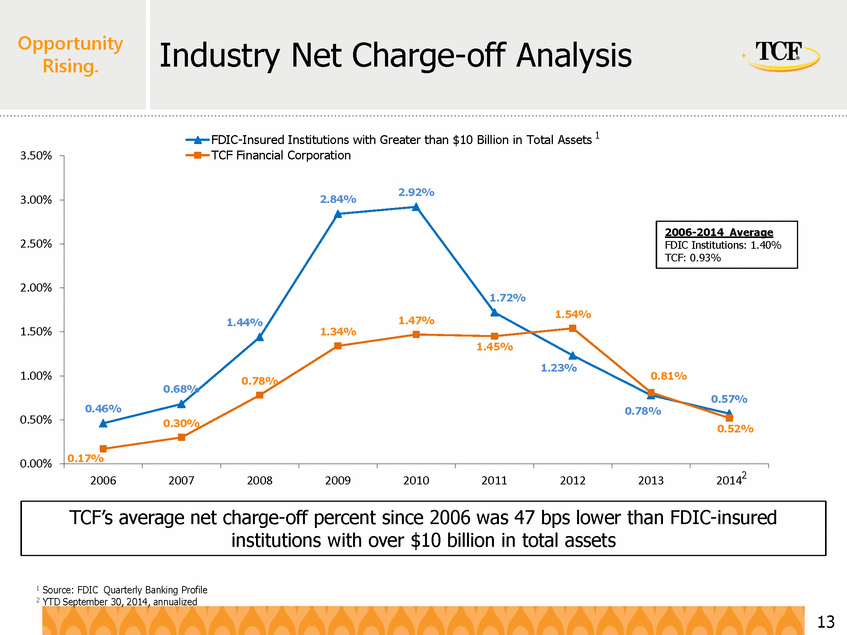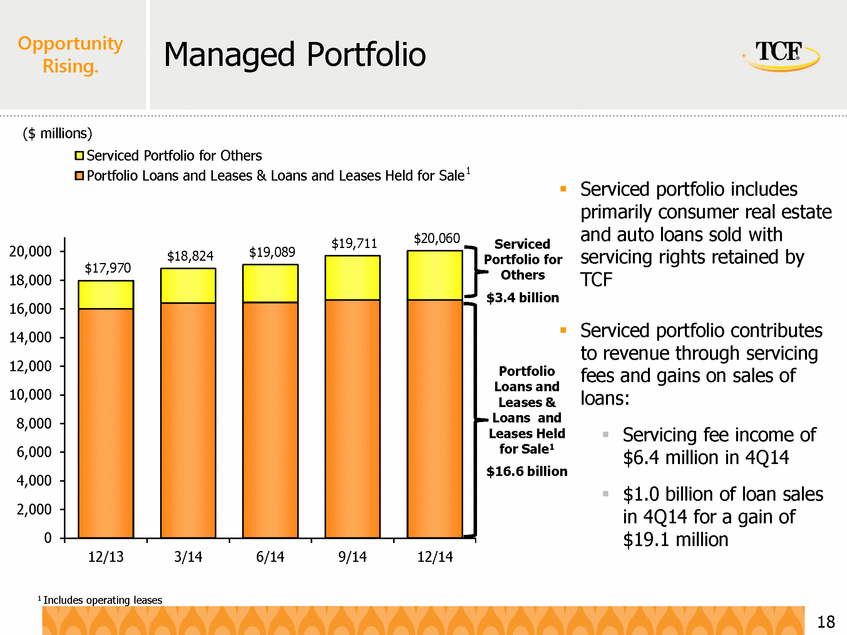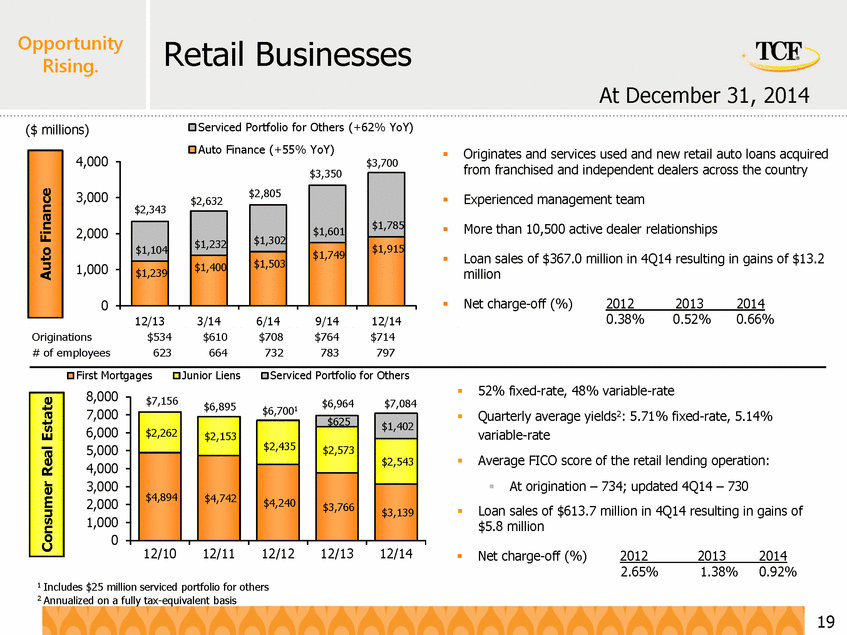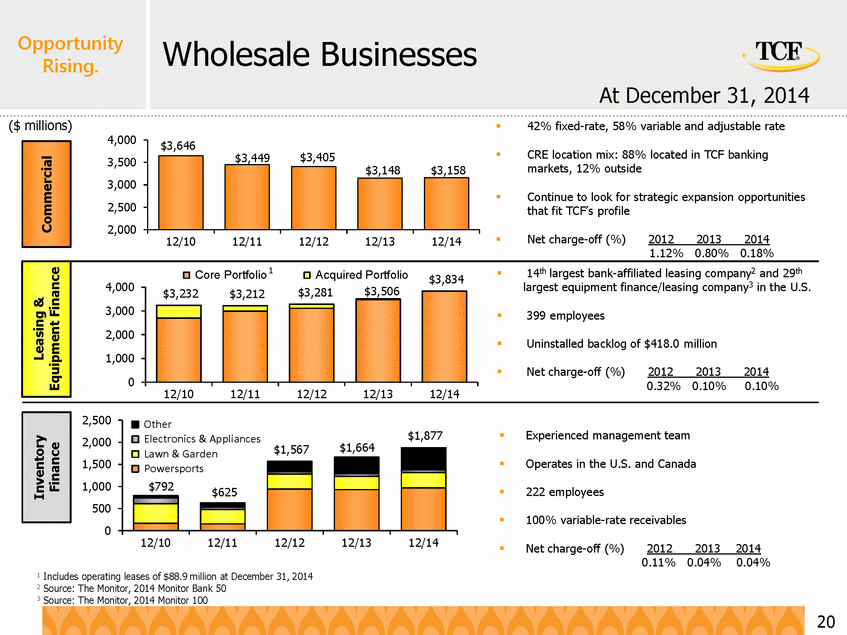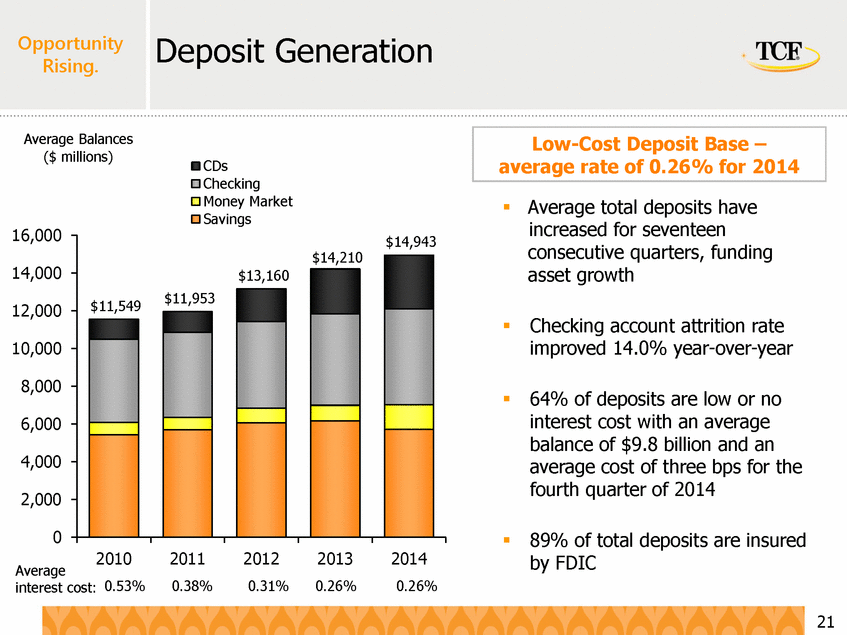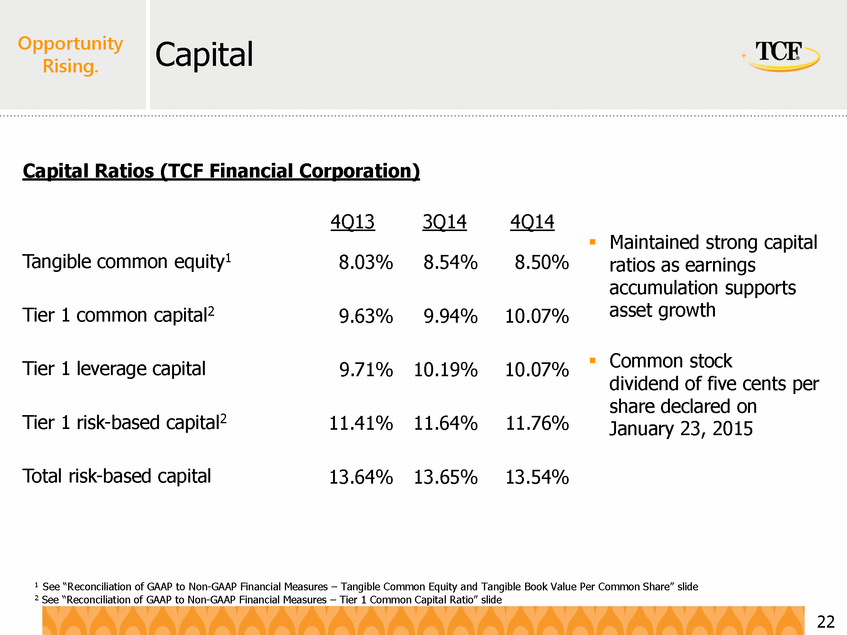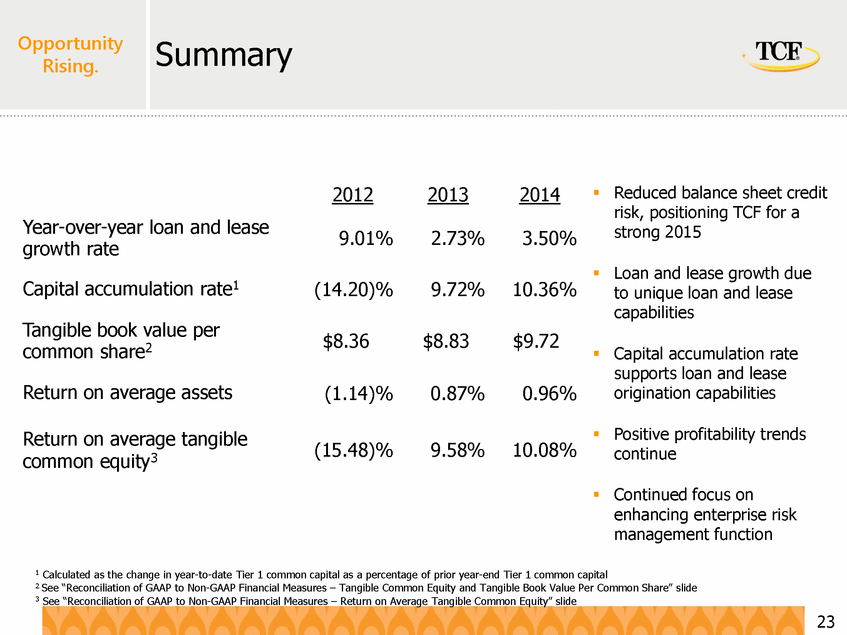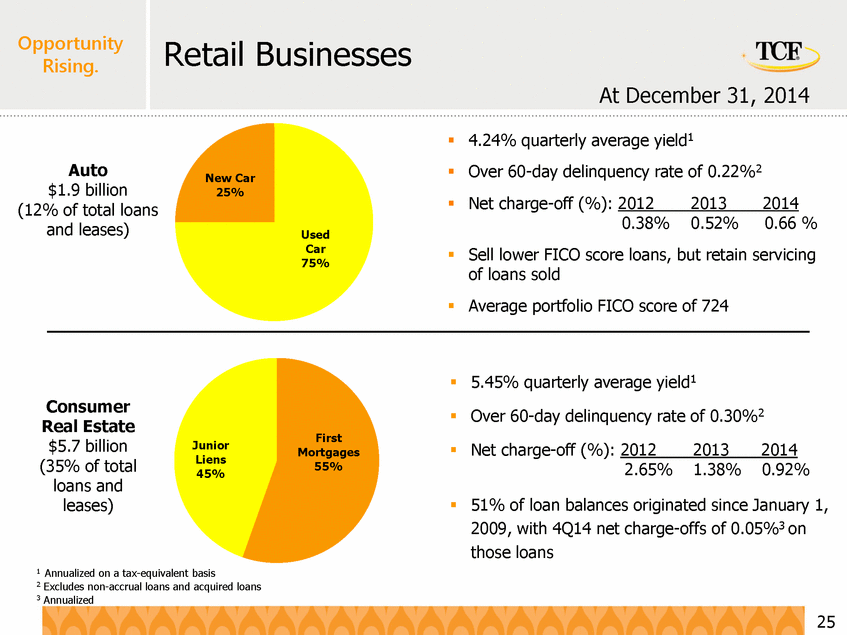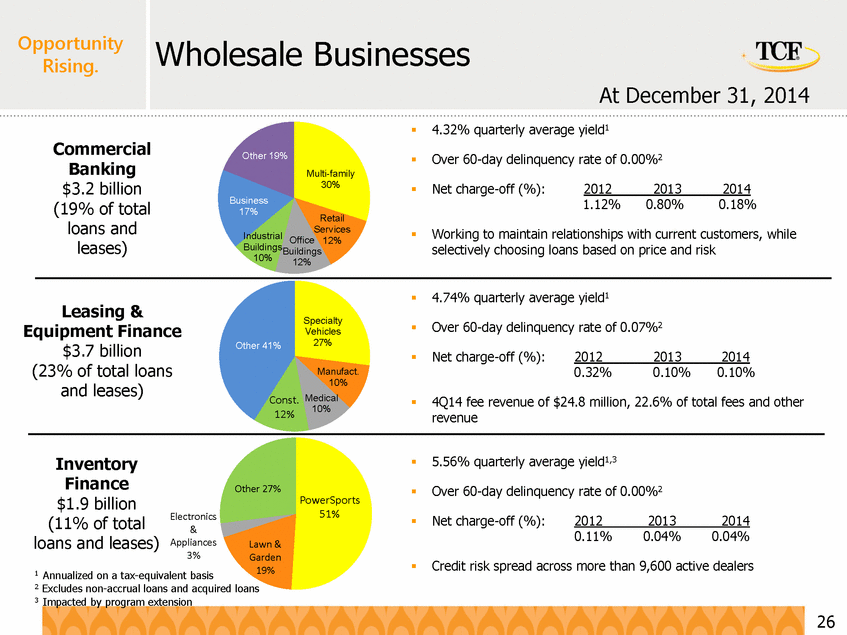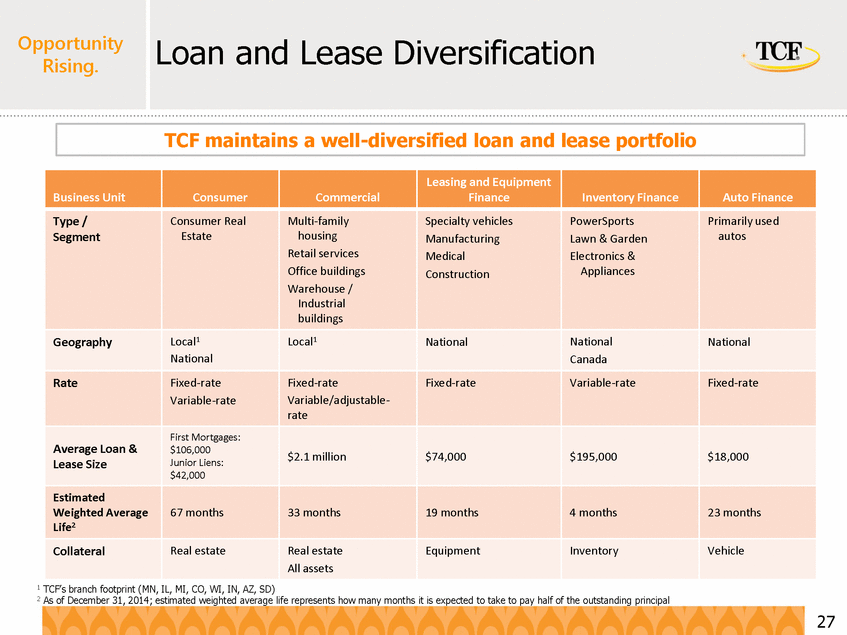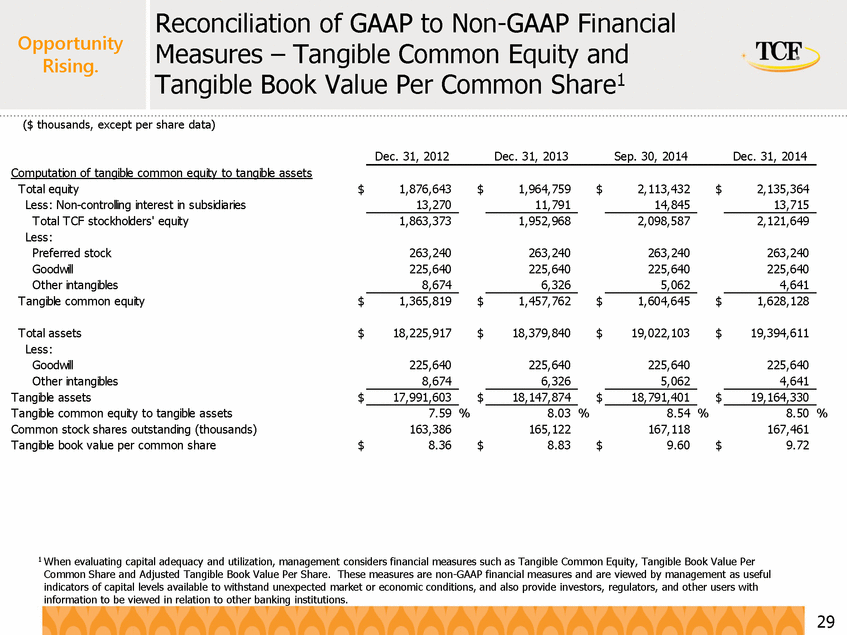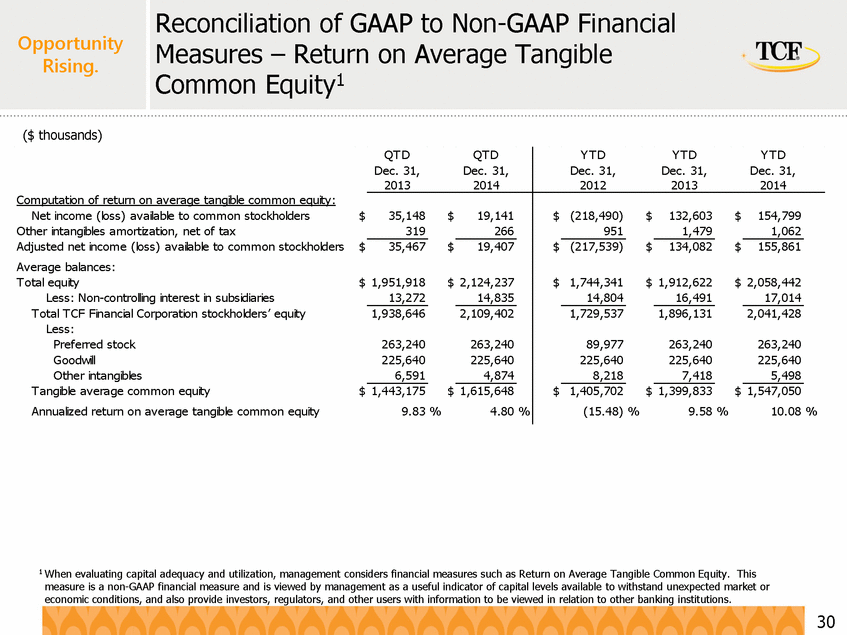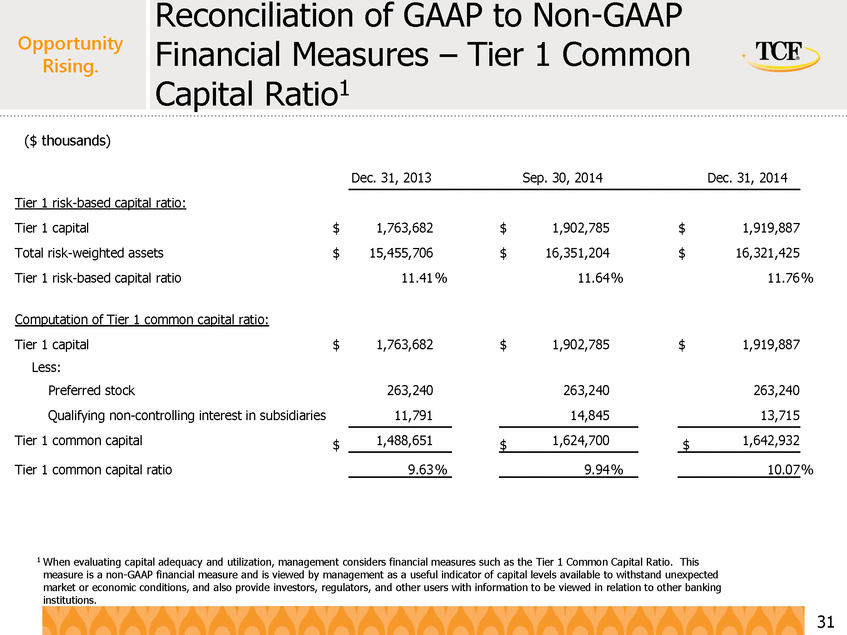Attached files
| file | filename |
|---|---|
| 8-K - 8-K - TCF FINANCIAL CORP | a15-4230_18k.htm |
Exhibit 99.1
|
|
TCF Financial Corporation 2014 Fourth Quarter Investor Presentation |
|
|
Cautionary Statements for Purposes of the Safe Harbor Provisions of the Securities Litigation Reform Act Any statements contained in this investor presentation regarding the outlook for the Company’s businesses and their respective markets, such as projections of future performance, guidance, statements of the Company’s plans and objectives, forecasts of market trends and other matters, are forward-looking statements based on the Company’s assumptions and beliefs. Such statements may be identified by such words or phrases as “will likely result,” “are expected to,” “will continue,” “outlook,” “will benefit,” “is anticipated,” “estimate,” “project,” “management believes” or similar expressions. These forward-looking statements are subject to certain risks and uncertainties that could cause actual results to differ materially from those discussed in such statements and no assurance can be given that the results in any forward-looking statement will be achieved. For these statements, TCF claims the protection of the safe harbor for forward-looking statements contained in the Private Securities Litigation Reform Act of 1995. Any forward-looking statement speaks only as of the date on which it is made, and we disclaim any obligation to subsequently revise any forward-looking statement to reflect events or circumstances after such date or to reflect the occurrence of anticipated or unanticipated events. Certain factors could cause the Company’s future results to differ materially from those expressed or implied in any forward-looking statements contained herein. These factors include the factors discussed in Part I, Item 1A of the Company’s Annual Report on Form 10-K for the year ended December 31, 2013, under the heading “Risk Factors,” the factors discussed below and any other cautionary statements, written or oral, which may be made or referred to in connection with any such forward-looking statements. Since it is not possible to foresee all such factors, these factors should not be considered as complete or exhaustive. Adverse Economic or Business Conditions; Competitive Conditions; Credit and Other Risks. Deterioration in general economic and banking industry conditions, including those arising from government shutdowns, defaults, anticipated defaults or rating agency downgrades of sovereign debt (including debt of the U.S.), or increases in unemployment in TCF’s primary banking markets; adverse economic, business and competitive developments such as shrinking interest margins, reduced demand for financial services and loan and lease products, deposit outflows, increased deposit costs due to competition for deposit growth and evolving payment system developments, deposit account attrition or an inability to increase the number of deposit accounts; customers completing financial transactions without using a bank; adverse changes in credit quality and other risks posed by TCF’s loan, lease, investment, securities held to maturity, and securities available for sale portfolios, including declines in commercial or residential real estate values, changes in the allowance for loan and lease losses dictated by new market conditions or regulatory requirements, or the inability of home equity line borrowers to make increased payments caused by increased interest rates or amortization of principal; deviations from estimates of prepayment rates and fluctuations in interest rates that result in decreases in value of assets such as interest-only strips that arise in connection with TCF’s loan sales activity; interest rate risks resulting from fluctuations in prevailing interest rates or other factors that result in a mismatch between yields earned on TCF’s interest-earning assets and the rates paid on its deposits and borrowings; foreign currency exchange risks; counterparty risk, including the risk of defaults by our counterparties or diminished availability of counterparties who satisfy our credit quality requirements; decreases in demand for the types of equipment that TCF leases or finances; the effect of any negative publicity. Legislative and Regulatory Requirements. New consumer protection and supervisory requirements and regulations, including those resulting from action by the Consumer Financial Protection Bureau and changes in the scope of Federal preemption of state laws that could be applied to national banks and their subsidiaries; the imposition of requirements that adversely impact TCF’s deposit, lending, loan collection and other business activities such as mortgage foreclosure moratorium laws, further regulation of financial institution campus banking programs, use by municipalities of eminent domain on property securing troubled residential mortgage loans, or imposition of underwriting or other limitations that impact the ability to use certain variable-rate products; changes affecting customer account charges and fee income, including changes to interchange rates; regulatory actions or changes in customer opt-in preferences with respect to overdrafts, which may have an adverse impact on TCF’s fee revenue; changes to bankruptcy laws which would result in the loss of all or part of TCF’s security interest due to collateral value declines; (continued) |
|
|
Cautionary Statements for Purposes of the Safe Harbor Provisions of the Securities Litigation Reform Act (continued) deficiencies in TCF’s compliance under the Bank Secrecy Act in past or future periods, which may result in regulatory enforcement action including monetary penalties; increased health care costs resulting from Federal health care reform; regulatory criticism and resulting enforcement actions or other adverse consequences such as increased capital requirements, higher deposit insurance assessments or monetary damages or penalties; heightened regulatory practices, requirements or expectations, including, but not limited to, requirements related to enterprise risk management, the Bank Secrecy Act and anti-money laundering compliance activity. Earnings/Capital Risks and Constraints, Liquidity Risks. Limitations on TCF’s ability to pay dividends or to increase dividends because of financial performance deterioration, regulatory restrictions or limitations; increased deposit insurance premiums, special assessments or other costs related to adverse conditions in the banking industry, the impact on banks of regulatory reform, including additional capital, leverage, liquidity and risk management requirements or changes in the composition of qualifying regulatory capital; adverse changes in securities markets directly or indirectly affecting TCF’s ability to sell assets or to fund its operations; diminished unsecured borrowing capacity resulting from TCF credit rating downgrades and unfavorable conditions in the credit markets that restrict or limit various funding sources; costs associated with new regulatory requirements or interpretive guidance relating to liquidity; uncertainties relating to future retail deposit account changes, including limitations on TCF’s ability to predict customer behavior and the impact on TCF’s fee revenues. Branching Risk; Growth Risks. Adverse developments affecting TCF’s supermarket banking relationships or any of the supermarket chains in which TCF maintains supermarket branches; costs related to closing underperforming branches; slower than anticipated growth in existing or acquired businesses; inability to successfully execute on TCF’s growth strategy through acquisitions or cross-selling opportunities; failure to expand or diversify TCF’s balance sheet through programs or new opportunities; failure to successfully attract and retain new customers, including the failure to attract and retain manufacturers and dealers to expand the inventory finance business; failure to effectuate, and risks of claims related to, sales and securitizations of loans; risks related to new product additions and addition of distribution channels (or entry into new markets) for existing products. Technological and Operational Matters. Technological or operational difficulties, loss or theft of information, cyber-attacks and other security breaches, counterparty failures and the possibility that deposit account losses (fraudulent checks, etc.) may increase; failure to keep pace with technological change, including the failure to develop and maintain technology necessary to satisfy customer demands. Litigation Risks. Results of litigation or government enforcement actions, including class action litigation or enforcement actions concerning TCF’s lending or deposit activities including account servicing processes or fees or charges, or employment practices; and possible increases in indemnification obligations for certain litigation against Visa U.S.A. and potential reductions in card revenues resulting from such litigation or other litigation against Visa. Accounting, Audit, Tax and Insurance Matters. Changes in accounting standards or interpretations of existing standards; federal or state monetary, fiscal or tax policies, including adoption of state legislation that would increase state taxes; ineffective internal controls; adverse federal, state or foreign tax assessments or findings in tax audits; lack of or inadequate insurance coverage for claims against TCF; potential for claims and legal action related to TCF’s fiduciary responsibilities. |
|
|
$3,158 $1,877 $1,915 $3,745 $3,164 $896 $2,543 . $19.4 billion national bank holding company headquartered in Minnesota . 45th largest publicly-traded U.S. based bank holding company by asset size1 . 379 bank branches in eight states . Over 146,000 small business banking relationships: . 75,800 checking accounts . 71,000 lending relationships . 85% of total assets are loans & leases . Tangible common equity to tangible assets of 8.50%2 . Tangible book value per common share of $9.722 . Return on average tangible common equity of 10.08%3 At December 31, 2014 A Well-Diversified Earning Asset Portfolio ($ millions) 1 Source: SNL Financial (9/30/14) 2 See “Reconciliation of GAAP to Non-GAAP Financial Measures – Tangible Common Equity and Tangible Book Value Per Common Share” slide 3 YTD; see “Reconciliation of GAAP to Non-GAAP Financial Measures – Return on Average Tangible Common Equity” slide Leasing & Equipment Finance 22% Inventory Finance 11% Consumer Real Estate & Other (First Mortgages) 18% Commercial Lending 18% Auto Finance 11% Funded by a Low Cost Deposit Base $5,213 $1,993 $5,195 $3,049 Savings 34% Money Market 13% CDs 20% Checking 33% Securities & Other 5% ($ millions) A Diversified Asset Portfolio Funded by a Low-Cost Deposit Base Consumer Real Estate (Junior Liens) 15% |
|
|
0.50 1.00 1.50 2.00 2.50 3.00 - 5.00 10.00 15.00 20.00 Price-to-Tangible Book Value (x) ROATCE (%) Strong Correlation between ROATCE and Price to Tangible Book Peer Group1,2,3 TCF (ROATCE – 10.08%; P/TBV – 1.63x)4 Linear Trendline ROATCE = 12.50% Banks maintaining an ROATCE of 12.50% should be able to achieve a price-to-tangible book value near 2.00x 1 All publicly-traded banks and thrifts with total assets between $10 and $50 billion at September 30, 2014 (source: SNL Financial) 2 Stock price as of December 31, 2014; ROATCE and Tangible Book Value as of QTD September 30, 2014 3 Peer banks not shown on graph due to scale: PB and WAL; peer banks excluded from analysis due to data not available or significant outlier: UMBF and FNFG 4 Stock price as of December 31, 2014; ROATCE and Tangible Book Value as of YTD December 31, 2014; See “Reconciliation of GAAP to Non-GAAP Financial Measures – Return on Average Tangible Common Equity” and “Reconciliation of GAAP to Non-GAAP Financial Measures – Tangible Common Equity and Tangible Book Value Per Common Share” slides |
|
|
Reduced Balance Sheet Credit Risk Summary Rationale Financial Impact . TCF marked to market and sold (servicing released) $405.9 million net book value of residential mortgage loans classified as TDRs (troubled debt restructurings) . These loans were transferred to held for sale during the quarter, net of a previously established provision for credit losses of $77 million, written down to fair value through an $18.3 million charge to provision for credit losses and sold at a loss of $4.8 million . $364.3 million of these loans were performing loans with an average maturity of 27 years and a fixed rate of 3% . $41.6 million of these loans were on non-accrual . TCF has a remaining accruing TDR residential portfolio of $112 million with reserves of 23% at December 31, 2014 . TCF significantly improved its credit risk metrics, reducing non-accrual loans and leases and accruing TDRs from 5.16% of total loans and leases at September 30, 2014 to 2.50% at December 31, 2014 . TDR residential loans, including non-accrual TDR loans, decreased from $611 million at September 30, 2014 to $200 million at December 31, 2014 . Will improve net interest income through redeployment of proceeds . Intersection of low rates, modest home value recovery and strong pool performance to date created opportunity to manage to a better long-term outcome . Will reduce operating expenses and regulatory expenses . Less than 3 year payback . Accretive in 2015 . 4Q14 EPS impact of ($.09) on sale and ($.08) for additional reserves . All capital metrics remain strong . Reduced long-term, low rate, fixed rate assets |
|
|
As a % of average assets: Net interest income 4.32% 3.12% Non-interest income 2.29% 1.04% Revenue 6.61% 4.16% Return on average assets 0.96% 0.84% Yield on loans and leases4 5.06% 4.50% Rate on deposits4 0.26% 0.32% Average balances as a % of average assets: Loans and leases 86.2% 65.5% Deposits 79.1% 76.0% Borrowings 7.4% 10.6% Equity 10.9% 11.9% Return on average tangible common equity5 10.08% 10.37% TCF 2014 Peer Group1,2,3 YTD 3Q14 Average . Well positioned in the banking industry despite charges related to reducing the balance sheet credit risk in the fourth quarter of 2014 . TCF has a higher margin due to more loans and leases as well as higher yielding loan and security portfolios than peers, along with lower rates on deposits . TCF has more fee income, as a percentage of average assets, due to a large and diversified base of revenue sources 1 Annualized 2 All U.S. publicly-traded banks and thrifts, excluding TCF, with total assets between $10 and $50 billion (source: SNL Financial) 3 Excluding non-recurring items for non-interest income and revenue 4 Presented on a fully tax-equivalent basis 5 See “Reconciliation of GAAP to Non-GAAP Financial Measures – Return on Average Tangible Common Equity” slide Well Positioned in the Banking Industry |
|
|
Fourth Quarter 2014 Highlights – Revenue $202 $201 $206 $204 $204 $105 $104 $104 $116 $110 4.67% 4.66% 4.65% 4.60% 4.49% 4.00% 4.20% 4.40% 4.60% 4.80% 5.00% 5.20% 5.40% 0 50 100 150 200 250 300 350 400 12/13 3/14 6/14 9/14 12/14 Non-interest Income Net Interest Income Net Interest Margin $305 $307 $310 $320 $314 1 Annualized 2 Interest income presented on a fully tax-equivalent basis 1 ($ millions) Non-interest Income 4Q14 revenue impacted by: . Growth in servicing fee income . Higher average loan and lease balances in the auto, leasing and equipment and inventory finance businesses . Net gains on the sale of auto loans 4Q14 net interest margin impacted by: . Continued margin reduction resulting from the persistent competitive low interest rate environment . One-time impact from a significant inventory finance program extension Deposit fees and service charges 36% ATM revenue 5% Card revenue 12% Leasing and equipment finance 22% Gains on sales of consumer real estate loans, net 5% Gains on sales of auto loans, net 12% Servicing fee income 6% Other 2% $110 million Revenue Diversification Interest Income2 Consumer real estate & other 38% Auto finance 9% Leasing and equipment finance 19% Commercial 15% Inventory finance 12% Loans and leases held for sale 3% Securities 2% Investments and other 2% $221 million |
|
|
($ millions) $541.7 $620.1 $459.9 $733.8 $601.3 0 200 400 600 800 1,000 12/13 3/14 6/14 9/14 12/14 Other Auto Consumer Real Estate & Other Consumer 1 $16.5 $24.5 $20.3 $29.5 $25.5 0 5 10 15 20 25 30 35 12/13 3/14 6/14 9/14 12/14 Servicing Fee Income Gains on Sales of Auto Loans, Net Gains on Sales of Consumer Real Estate Loans, Net Loan and Lease Sales Impact on Revenue Loan and Lease Sales - Revenue . Loan sales have been a core competency since 4Q11 . Loan sales provide flexibility to the organization: . Diversify areas of product and geographic concentration . Supports capital and liquidity . Provides additional revenue source 1 Excludes TDR portfolio sale of $405.9 million (servicing released) . Completed first auto loan securitization in 3Q14: . $256.3 million securitization with a gain of $7.4 million . Provides additional funding diversification |
|
|
Loan and Lease Yields1 - Revenue Utilize diverse lending mix to remain competitive despite low rate environment 1 Annualized and presented on a fully tax-equivalent basis 2 Impacted by program extension 3 All U.S. publicly-traded banks and thrifts, excluding TCF, with total assets between $10 and $50 billion as of September 30, 2014 that have reported loan and lease yields for the past four quarters (source: SNL Financial) N.A. Not available 4Q13 1Q14 2Q14 3Q14 4Q14 Consumer Real Estate: First mortgages 5.28% 5.18% 5.26% 5.25% 5.26% Junior liens 5.73 5.73 5.75 5.71 5.69 Commercial 4.65 4.63 4.57 4.37 4.32 Leasing & Equipment Finance 4.89 4.75 4.72 4.71 4.74 Inventory Finance 5.85 5.98 5.93 6.18 5.562 Auto Finance 4.64 4.52 4.43 4.36 4.24 Total Loans and Leases 5.17 5.11 5.10 5.05 4.96 Peer Group3 Average 4.68 4.54 4.53 4.50 N.A. |
|
|
2.17% 2.03% 2.02% 2.08% 1.71% 0.00% 1.00% 2.00% 3.00% 4.00% 5.00% 6.00% 0 100 200 300 400 500 12/13 3/14 6/14 9/14 12/14 Other Real Estate Owned Non-accrual Loans & Leases NPAs / Loans & Leases and Other Real Estate Owned $346 $343 $325 $330 $282 ($ millions) 60+ Day Delinquencies1 1 Excludes acquired portfolios and non-accrual loans 2 Annualized 0.19% 0.19% 0.18% 0.17% 0.14% 0.00% 0.10% 0.20% 0.30% 12/13 3/14 6/14 9/14 12/14 $23 $14 $10 $16 $16 $22 $18 0 10 20 30 40 50 60 12/13 3/14 6/14 9/14 12/14 Normal Provision Added Reserve TDR Sale Non-Performing Assets Provision for Credit Losses ($ millions) Credit Performance 0.76% 0.43% 0.45% 0.66% 0.40% 0.00% 0.20% 0.40% 0.60% 0.80% 1.00% 12/13 3/14 6/14 9/14 12/14 Net Charge-offs2 $56 Opportunity Rising. |
|
|
Significant Improvement in Asset Quality . Significant reduction in non-performing assets and accruing TDRs . Allows for redeployment of proceeds into earning assets with better risk profiles . Improved portfolio composition should result in lower credit and operating costs in future periods 6.57% 6.50% 6.30% 6.00% 5.93% 5.74% 5.46% 5.43% 5.16% 2.50% 0.0% 2.0% 4.0% 6.0% 8.0% 3Q12 4Q12 1Q13 2Q13 3Q13 4Q13 1Q14 2Q14 3Q14 4Q14 Non-accrual Loans and Leases and Accruing TDRs / Total Loans and Leases Median: 5.93% |
|
|
0.46% 0.68% 1.44% 2.84% 2.92% 1.72% 1.23% 0.78% 0.57% 0.17% 0.30% 0.78% 1.34% 1.47% 1.45% 1.54% 0.81% 0.52% 0.00% 0.50% 1.00% 1.50% 2.00% 2.50% 3.00% 3.50% 2006 2007 2008 2009 2010 2011 2012 2013 2014 FDIC-Insured Institutions with Greater than $10 Billion in Total Assets TCF Financial Corporation TCF’s average net charge-off percent since 2006 was 47 bps lower than FDIC-insured institutions with over $10 billion in total assets 2006-2014 Average FDIC Institutions: 1.40% TCF: 0.93% 1 Source: FDIC Quarterly Banking Profile 2 YTD September 30, 2014, annualized 1 2 Industry Net Charge-off Analysis |
|
|
$220 $217 $213 $220 $222 0 50 100 150 200 250 12/13 3/14 6/14 9/14 12/14 Foreclosed Real Estate and Other Credit Costs . Continued expense optimization expected to be achieved by: . Asset growth across the businesses . Continued focus on process optimization and automation . Increased due to the annual pension plan valuation adjustment . Includes a favorable FDIC rate, of which a portion is a one-time catch-up . Total expense base supports growth in the serviced portfolio as well as total assets on the balance sheet ($ millions) Other (including FDIC Insurance, Advertising & Marketing, and Occupancy & Equipment) Compensation & Employee Benefits % of Total Avg Assets & Serviced Portfolio1: 4.38% 4.18% 3.97% 1 Annualized Total Avg Assets & Serviced Portfolio: $20,135 $20,799 $21,467 $21,719 4.05% Actively Manage Expense Base $22,490 3.94% |
|
|
. Annualized loan and lease growth of 24%1 during 4Q14 excluding $1.0 billion in loan sales . Multiple business segments give TCF options to strategically invest capital in light of competitive environments . Average total deposits, TCF’s primary funding source for asset growth, have increased for seventeen consecutive quarters . Low-cost deposit base with an average rate of 0.26% in 2014 ($ millions) 12/13 12/14 Change from 12/13 Cash and Investments $ 1,009 $ 1,201 19.0 % Securities and Loans HFS 651 810 24.5 Consumer real estate and other 6,366 5,707 (10.4) Commercial 3,148 3,158 0.3 Leasing and equipment finance 3,429 3,745 9.2 Inventory finance 1,664 1,877 12.8 Auto finance 1,240 1,915 54.5 Total loans and leases 15,847 16,402 3.5 All other assets 873 982 12.5 Total assets $ 18,380 $ 19,395 5.5 Checking $ 4,981 $ 5,195 4.3 Savings 6,194 5,213 (15.8) Money market 832 1,993 139.6 Certificates of deposit 2,426 3,049 25.7 Total deposits 14,433 15,450 7.0 Borrowings 1,488 1,237 (16.9) Other liabilities 494 573 16.0 Equity 1,965 2,135 8.7 Total liabilities and equity $ 18,380 $ 19,395 5.5 Asset Growth Funded by Deposits 1 Includes loans and leases held for sale |
|
|
Loan and Lease Balance Rollforward1 ($ millions) 4Q13 4Q14 Change Period Beginning Balance $15,822 $16,530 $708 New Originations 3,073 3,459 386 Less Run-off2 2,426 2,448 22 Subtotal 647 1,011 364 Annualized Growth Rate3 16% 24% Less Loan & Lease Sales 542 1,007 465 Period Ending Balance $15,927 $16,534 $607 4Q14 vs. 4Q13 Originations Sales Consumer Real Estate $104 $411 Auto Finance 179 131 Total Retail 283 542 Commercial (51) (87) Leasing (2) 10 Inventory Finance 4 156 - Total Wholesale 103 (77) Total Lending $386 $465 Change in Originations & Sales 1 Includes portfolio loans and leases and loans and leases held for sale 2 Includes activity from payments, pre-payments and charge-offs 3 Excludes loan and lease sales 4 Origination levels impacted by the high velocity of fundings and repayments with dealers . Continued strong origination capabilities . Diversity across asset classes reduces concentration risk . Originate to sell capability a core competency . Impacted by $405.9 million of TDR loans sold Loan and lease origination opportunities continue ($ millions) |
|
|
Loan and Lease Balance Rollforward1 ($ millions) 2013 2014 Change Period Beginning Balance $15,436 $15,927 $491 New Originations 12,025 13,490 1,465 Less Run-off2 9,828 10,062 234 Subtotal 2,197 3,428 1,231 Annualized Growth Rate3 14% 22% Less Loan & Lease Sales 1,706 2,821 1,115 Period Ending Balance $15,927 $16,534 $607 2014 vs. 2013 Originations Sales Consumer Real Estate $ 95 $ 656 Auto Finance 849 538 Total Retail 944 1,194 Commercial 38 (85) Leasing 143 7 Inventory Finance 4 340 (1) Total Wholesale 521 (79) Total Lending $1,465 $1,115 Change in Originations & Sales 1 Includes portfolio loans and leases and loans and leases held for sale 2 Includes activity from payments, pre-payments and charge-offs 3 Excludes loan and lease sales 4 Origination levels impacted by the high velocity of fundings and repayments with dealers . Continued strong origination capabilities . Diversity across asset classes reduces concentration risk . Originate to sell capability a core competency . Impacted by $405.9 million of TDR loans sold Loan and lease origination opportunities continue ($ millions) |
|
|
$17,970 $18,824 $19,089 $19,711 $20,060 0 2,000 4,000 6,000 8,000 10,000 12,000 14,000 16,000 18,000 20,000 12/13 3/14 6/14 9/14 12/14 Serviced Portfolio for Others Portfolio Loans and Leases & Loans and Leases Held for Sale 1 Managed Portfolio ($ millions) . Serviced portfolio includes primarily consumer real estate and auto loans sold with servicing rights retained by TCF . Serviced portfolio contributes to revenue through servicing fees and gains on sales of loans: . Servicing fee income of $6.4 million in 4Q14 . $1.0 billion of loan sales in 4Q14 for a gain of $19.1 million Serviced Portfolio for Others $3.4 billion Portfolio Loans and Leases & Loans and Leases Held for Sale1 $16.6 billion 1 Includes operating leases |
|
|
$1,239 $1,400 $1,503 $1,749 $1,915 $1,104 $1,232 $1,302 $1,601 $1,785 0 1,000 2,000 3,000 4,000 12/13 3/14 6/14 9/14 12/14 Serviced Portfolio for Others (+62% YoY) Auto Finance (+55% YoY) . Originates and services used and new retail auto loans acquired from franchised and independent dealers across the country . Experienced management team . More than 10,500 active dealer relationships . Loan sales of $367.0 million in 4Q14 resulting in gains of $13.2 million . Net charge-off (%) 2012 2013 2014 0.38% 0.52% 0.66% 1 Includes $25 million serviced portfolio for others 2 Annualized on a fully tax-equivalent basis ($ millions) . 52% fixed-rate, 48% variable-rate . Quarterly average yields2: 5.71% fixed-rate, 5.14% variable-rate . Average FICO score of the retail lending operation: . At origination – 734; updated 4Q14 – 730 . Loan sales of $613.7 million in 4Q14 resulting in gains of $5.8 million . Net charge-off (%) 2012 2013 2014 2.65% 1.38% 0.92% Consumer Real Estate $2,343 $2,805 $2,632 At December 31, 2014 Retail Businesses $3,350 Originations $534 $610 $708 $764 $714 # of employees 623 664 732 783 797 Auto Finance $4,894 $4,742 $4,240 $3,766 $3,139 $2,262 $2,153 $2,435 $2,573 $2,543 $625 $1,402 $7,156 $6,895 $6,7001 $6,964 $7,084 0 1,000 2,000 3,000 4,000 5,000 6,000 7,000 8,000 12/10 12/11 12/12 12/13 12/14 First Mortgages Junior Liens Serviced Portfolio for Others $3,700 |
|
|
$3,646 $3,449 $3,405 $3,148 $3,158 2,000 2,500 3,000 3,500 4,000 12/10 12/11 12/12 12/13 12/14 ($ millions) . 42% fixed-rate, 58% variable and adjustable rate . CRE location mix: 88% located in TCF banking markets, 12% outside . Continue to look for strategic expansion opportunities that fit TCF’s profile . Net charge-off (%) 2012 2013 2014 1.12% 0.80% 0.18% 1 Includes operating leases of $88.9 million at December 31, 2014 2 Source: The Monitor, 2014 Monitor Bank 50 3 Source: The Monitor, 2014 Monitor 100 $3,232 $3,212 $3,281 $3,506 $3,834 0 1,000 2,000 3,000 4,000 12/10 12/11 12/12 12/13 12/14 Core Portfolio Acquired Portfolio 1 . 14th largest bank-affiliated leasing company2 and 29th largest equipment finance/leasing company3 in the U.S. . 399 employees . Uninstalled backlog of $418.0 million . Net charge-off (%) 2012 2013 2014 0.32% 0.10% 0.10% . Experienced management team . Operates in the U.S. and Canada . 222 employees . 100% variable-rate receivables . Net charge-off (%) 2012 2013 2014 0.11% 0.04% 0.04% Wholesale Businesses Leasing & Equipment Finance Commercial Inventory Finance At December 31, 2014 $792 $625 $1,567 $1,664 $1,877 0 500 1,000 1,500 2,000 2,500 12/10 12/11 12/12 12/13 12/14 Other Electronics & Appliances Lawn & Garden Powersports |
|
|
Deposit Generation $11,549 $11,953 $13,160 $14,210 $14,943 0 2,000 4,000 6,000 8,000 10,000 12,000 14,000 16,000 2010 2011 2012 2013 2014 CDs Checking Money Market Savings . Average total deposits have increased for seventeen consecutive quarters, funding asset growth . Checking account attrition rate improved 14.0% year-over-year . 64% of deposits are low or no interest cost with an average balance of $9.8 billion and an average cost of three bps for the fourth quarter of 2014 . 89% of total deposits are insured by FDIC 0.53% 0.38% 0.31% 0.26% 0.26% Average interest cost: Average Balances ($ millions) Low-Cost Deposit Base – average rate of 0.26% for 2014 |
|
|
Capital 1 See “Reconciliation of GAAP to Non-GAAP Financial Measures – Tangible Common Equity and Tangible Book Value Per Common Share” slide 2 See “Reconciliation of GAAP to Non-GAAP Financial Measures – Tier 1 Common Capital Ratio” slide 4Q13 3Q14 4Q14 Tangible common equity1 8.03% 8.54% 8.50% Tier 1 common capital2 9.63% 9.94% 10.07% Tier 1 leverage capital 9.71% 10.19% 10.07% Tier 1 risk-based capital2 11.41% 11.64% 11.76% Total risk-based capital 13.64% 13.65% 13.54% Capital Ratios (TCF Financial Corporation) . Maintained strong capital ratios as earnings accumulation supports asset growth . Common stock dividend of five cents per share declared on January 23, 2015 |
|
|
Summary 1 Calculated as the change in year-to-date Tier 1 common capital as a percentage of prior year-end Tier 1 common capital 2 See “Reconciliation of GAAP to Non-GAAP Financial Measures – Tangible Common Equity and Tangible Book Value Per Common Share” slide 3 See “Reconciliation of GAAP to Non-GAAP Financial Measures – Return on Average Tangible Common Equity” slide 2012 2013 2014 Year-over-year loan and lease growth rate 9.01% 2.73% 3.50% Capital accumulation rate1 (14.20)% 9.72% 10.36% Tangible book value per common share2 $8.36 $8.83 $9.72 Return on average assets (1.14)% 0.87% 0.96% Return on average tangible common equity3 (15.48)% 9.58% 10.08% . Reduced balance sheet credit risk, positioning TCF for a strong 2015 . Loan and lease growth due to unique loan and lease capabilities . Capital accumulation rate supports loan and lease origination capabilities . Positive profitability trends continue . Continued focus on enhancing enterprise risk management function |
|
|
Appendix |
|
|
Used Car 75% New Car 25% First Mortgages 55% Junior Liens 45% Other 20% . 5.45% quarterly average yield1 . Over 60-day delinquency rate of 0.30%2 . Net charge-off (%): 2012 2013 2014 2.65% 1.38% 0.92% . 51% of loan balances originated since January 1, 2009, with 4Q14 net charge-offs of 0.05%3 on those loans Auto $1.9 billion (12% of total loans and leases) Consumer Real Estate $5.7 billion (35% of total loans and leases) . 4.24% quarterly average yield1 . Over 60-day delinquency rate of 0.22%2 . Net charge-off (%): 2012 2013 2014 0.38% 0.52% 0.66 % . Sell lower FICO score loans, but retain servicing of loans sold . Average portfolio FICO score of 724 1 Annualized on a tax-equivalent basis 2 Excludes non-accrual loans and acquired loans 3 Annualized At December 31, 2014 Retail Businesses |
|
|
Wholesale Businesses Specialty Vehicles 27% Manufact. 10% Medical 10% Other 41% Multi-family 30% Retail Services 12% Office Buildings 12% Industrial Buildings 10% Business 17% Other 19% Const. 12% Other 20% Lawn & Garden 19% Electronics & Appliances 3% Other 27% PowerSports 51% Leasing & Equipment Finance $3.7 billion (23% of total loans and leases) . 4.32% quarterly average yield1 . Over 60-day delinquency rate of 0.00%2 . Net charge-off (%): 2012 2013 2014 1.12% 0.80% 0.18% . Working to maintain relationships with current customers, while selectively choosing loans based on price and risk Commercial Banking $3.2 billion (19% of total loans and leases) Inventory Finance $1.9 billion (11% of total loans and leases) . 4.74% quarterly average yield1 . Over 60-day delinquency rate of 0.07%2 . Net charge-off (%): 2012 2013 2014 0.32% 0.10% 0.10% . 4Q14 fee revenue of $24.8 million, 22.6% of total fees and other revenue . 5.56% quarterly average yield1,3 . Over 60-day delinquency rate of 0.00%2 . Net charge-off (%): 2012 2013 2014 0.11% 0.04% 0.04% . Credit risk spread across more than 9,600 active dealers 1 Annualized on a tax-equivalent basis 2 Excludes non-accrual loans and acquired loans 3 Impacted by program extension At December 31, 2014 |
|
|
Loan and Lease Diversification Business Unit Consumer Commercial Leasing and Equipment Finance Inventory Finance Auto Finance Type / Segment Consumer Real Estate Multi-family housing Retail services Office buildings Warehouse / Industrial buildings Specialty vehicles Manufacturing Medical Construction PowerSports Lawn & Garden Electronics & Appliances Primarily used autos Geography Local1 National Local1 National National Canada National Rate Fixed-rate Variable-rate Fixed-rate Variable/adjustable- rate Fixed-rate Variable-rate Fixed-rate Average Loan & Lease Size First Mortgages: $106,000 Junior Liens: $42,000 $2.1 million $74,000 $195,000 $18,000 Estimated Weighted Average Life2 67 months 33 months 19 months 4 months 23 months Collateral Real estate Real estate All assets Equipment Inventory Vehicle TCF maintains a well-diversified loan and lease portfolio 1 TCF’s branch footprint (MN, IL, MI, CO, WI, IN, AZ, SD) 2 As of December 31, 2014; estimated weighted average life represents how many months it is expected to take to pay half of the outstanding principal |
|
|
Loan and Lease Geographic Diversification ($ millions) 1 Individual states with less than $240 million in total At December 31, 2014 Consumer Real Estate Commercial Real Estate and Commercial Business Leasing and Equipment Finance Inventory Finance Auto Finance Other Total Minnesota 1,903.5 $ 814.2 $ 98.6 $ 62.7 $ 36.2 $ 10.1 $ 2,925.3 $ Illinois 1,429.2 566.3 130.1 44.7 90.2 5.3 2,265.8 California 651.4 33.3 523.4 57.9 344.8 - 1,610.8 Michigan 556.2 493.2 140.2 64.5 36.6 2.7 1,293.4 Wisconsin 315.8 535.4 62.0 54.7 18.0 1.1 987.0 Colorado 399.8 167.8 64.4 21.5 38.8 4.4 696.7 Texas- 30.5 365.9 132.5 122.5 - 651.4 Canada- - 1.0 525.9 - - 526.9 Florida 16.8 47.2 167.7 71.3 103.3 0.1 406.4 New York 7.7 - 200.2 55.1 80.5 - 343.5 Ohio 5.2 70.7 133.5 52.1 39.5 - 301.0 Pennsylvania 15.5 - 153.5 54.6 76.6 - 300.2 North Carolina 0.1 21.7 133.8 38.0 65.6 - 259.2 Arizona 71.1 32.3 82.7 13.1 59.6 0.3 259.1 New Jersey 18.0 - 147.0 18.2 66.9 - 250.1 Other 1292.1 345.1 1,341.3 610.3 735.9 0.1 3,324.8 Total 5,682.4 $ 3,157.7 $ 3,745.3 $ 1,877.1 $ 1,915.0 $ 24.1$ 16,401.6 $ |
|
|
Reconciliation of GAAP to Non-GAAP Financial Measures – Tangible Common Equity and Tangible Book Value Per Common Share1 1 When evaluating capital adequacy and utilization, management considers financial measures such as Tangible Common Equity, Tangible Book Value Per Common Share and Adjusted Tangible Book Value Per Share. These measures are non-GAAP financial measures and are viewed by management as useful indicators of capital levels available to withstand unexpected market or economic conditions, and also provide investors, regulators, and other users with information to be viewed in relation to other banking institutions. ($ thousands, except per share data) Dec. 31, 2012 Dec. 31, 2013 Sep. 30, 2014 Dec. 31, 2014 Computation of tangible common equity to tangible assets Total equity $1,876,643 $1,964,759 $2,113,432 $2,135,364 Less: Non-controlling interest in subsidiaries 13,270 11,791 14,845 13,715 Total TCF stockholders' equity 1,863,373 1,952,968 2,098,587 2,121,649 Less: Preferred stock 263,240 263,240 263,240 263,240 Goodwill 225,640 225,640 225,640 225,640 Other intangibles 8,674 6,326 5,062 4,641 Tangible common equity $1,365,819 $1,457,762 $1,604,645 $1,628,128 Total assets $18,225,917 $18,379,840 $19,022,103 $19,394,611 Less: Goodwill 225,640 225,640 225,640 225,640 Other intangibles 8,674 6,326 5,062 4,641 Tangible assets $17,991,603 $18,147,874 $18,791,401 $19,164,330 Tangible common equity to tangible assets 7.59 % 8.03 % 8.54 % 8.50 % Common stock shares outstanding (thousands)163,386 165,122 167,118 167,461 Tangible book value per common share $8.36 $8.83 $9.60 $9.72 |
|
|
Reconciliation of GAAP to Non-GAAP Financial Measures – Return on Average Tangible Common Equity 1 1 When evaluating capital adequacy and utilization, management considers financial measures such as Return on Average Tangible Common Equity. This measure is a non-GAAP financial measure and is viewed by management as a useful indicator of capital levels available to withstand unexpected market or economic conditions, and also provide investors, regulators, and other users with information to be viewed in relation to other banking institutions. ($ thousands) QTDQTDYTDYTDYTD Dec. 31, 2013 Dec. 31, 2014 Dec. 31, 2012 Dec. 31, 2013 Dec. 31, 2014 Computation of return on average tangible common equity: Net income (loss) available to common stockholders $35,148 $19,141 $ (218,490) $132,603 $154,799 Other intangibles amortization, net of tax 3192669511,479 1,062 Adjusted net income (loss) available to common stockholders $35,467 $19,407 $ (217,539) $134,082 $155,861 Average balances: Total equity $1,951,918 $2,124,237 $1,744,341 $1,912,622 $2,058,442 Less: Non-controlling interest in subsidiaries 13,272 14,835 14,80 416,491 17,014 Total TCF Financial Corporation stockholders’ equity 1,938,646 2,109,402 1,729,537 1,896,131 2,041,428 Less: Preferred stock 263,240 263,240 89,977 263,240 263,240 Goodwill 225,640 225,640 225,640 225,640 225,640 Other intangibles 6 ,591 4,874 8,218 7,418 5,498 Tangible average common equity $1,443,175 $1,615,648 $1,405,702 $1,399,833 $1,547,050 Annualized return on average tangible common equity 9.83% 4.80% (15.48)% 9.58% 10.08 % |
|
|
Reconciliation of GAAP to Non-GAAP Financial Measures – Tier 1 Common Capital Ratio1 ($ thousands) 1 When evaluating capital adequacy and utilization, management considers financial measures such as the Tier 1 Common Capital Ratio. This measure is a non-GAAP financial measure and is viewed by management as a useful indicator of capital levels available to withstand unexpected market or economic conditions, and also provide investors, regulators, and other users with information to be viewed in relation to other banking institutions. Dec. 31, 2013 Sep. 30, 2014 Dec. 31, 2014 Tier 1 risk-based capital ratio: Tier 1 capital $ 1,763,682 $ 1,902,785 $ 1,919,887 Total risk-weighted assets $ 15,455,706 $ 16,351,204 $ 16,321,425 Tier 1 risk-based capital ratio 11.41 % 11.64 % 11.76 % Computation of Tier 1 common capital ratio: Tier 1 capital $ 1,763,682 $ 1,902,785 $ 1,919,887 Less: Preferred stock 263,240 263,240 263,240 Qualifying non-controlling interest in subsidiaries 11,791 14,845 13,715 Tier 1 common capital $ 1,488,651 $ 1,624,700 $ 1,642,932 Tier 1 common capital ratio 9.63 % 9.94 % 10.07 % |




